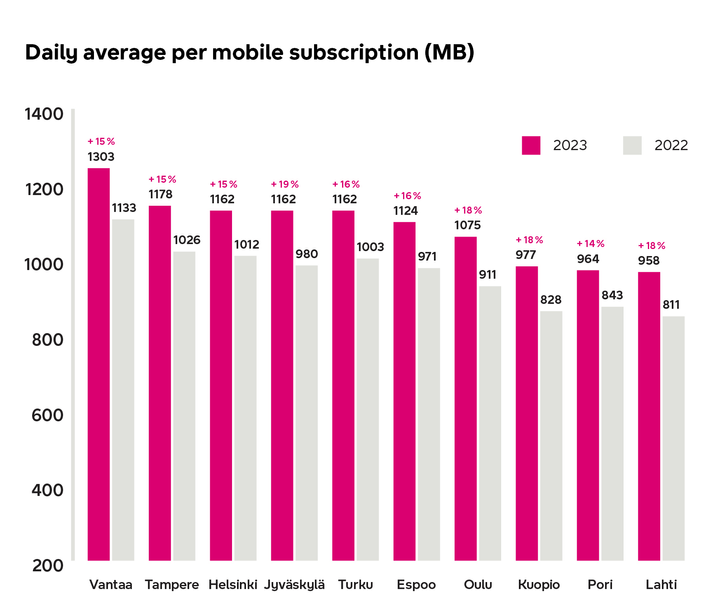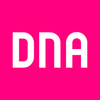DNA’s comparison reveals different cities’ mobile phone data usage: Vantaa is Finland’s data capital
This year, Vantaa has the highest per-customer data usage with DNA’s postpaid subscriptions, reveals DNA’s mobile data usage comparison of Finland’s ten largest cities. Customers in Vantaa used an average of 1,303 megabytes of mobile data per day, almost 40% more than people in Lahti. Tampere is in second place, and Helsinki, Jyväskylä and Turku all claim a shared third place with identical data usage across all three cities.

According to DNA’s Mobile Business VP Cedric Kamtsan, Vantaa’s first-place position can be largely explained by the city’s high number of families and comparatively long commutes using public transport.
“Vantaa is a popular city with families, which may be one explanation for its high data usage. Young people have significantly higher data usage than older people. Another possible explanation is that many people commute using public transport and spend much of the journey on their phones. A significant proportion of jobs in the Greater Helsinki area are located in the city, and the commute from Vantaa to Helsinki can easily take an hour each way, whereas the commute for people already living in the city may only take a few minutes on the metro”, Kamtsan says.
Average data usage saw an increase of 16%
Naturally, mobile data usage on smartphones has also increased in all other large towns and cities, rising by an average of about 16%. This is largely due to 5G phone usage increasing from 17% to 50% in the past two years (DNA’s Digital Life survey, June 2023*).
“The improvement of the 5G network and the popularisation of 5G devices has increased data consumption in itself, because watching video content uses a lot of data, and that only increases as image quality improves. There is a well-established general trend where the improvement of networks, endpoints and services makes for a better user experience when consuming content, which in turn makes that content even more appealing. Even if you’re not spending any more time on your smartphone, improved image quality means you’re still using more and more data”, Kamtsan explains.
Calculated based on place of residence, DNA’s 5G network already reaches nearly 93 per cent of the Finnish population – more than five million people across 239 localities.
Vantaa’s figures are equivalent to streaming a several-hours-long movie every day
What can you do with 1,300 megabytes of mobile data? Depending on the browser and program, watching a one-hour video in standard definition uses about 300–600 megabytes, meaning 1,300 megabytes is enough to watch a long movie in that quality. In high definition, 1,300 megabytes is enough for about 90–120 minutes of video watching. The table below shows a rough approximation of how much data different activities use.
With data usage accelerating year by year, Kamtsan emphasises the importance of operators continuing to develop their services to meet growing customer demand.
“Continuous improvement in image quality means that the pace of network capacity expansion has to race to keep up with it, even outpace it if we want to stay one step ahead. This work is always ongoing: We invest heavily in technologies that improve networks and connections to ensure our mobile data experience remains excellent going forward.”
Roughly how much data does it take to …
- Send 50 emails without attachments? 1 MB
- Upload a picture to social media? 5MB
- Read online magazines for one hour? 100–200 MB
- Stream music for one hour? 100–200 MB
- Watch a one-hour video in standard definition? 300–600 MB
- Watch a one-hour video in high definition? 700–3,000 MB
Figures are estimated data usage averages and can vary significantly from user to user.
*Source: DNA’s Digital Life survey 2023 (in Finnish).
Media enquiries:
Cedric Kamtsan, Vice President, Mobile Business, DNA Plc, tel. +358 (0)44 906 2377, cedric.kamtsan@dna.fi
DNA Corporate Communications, tel. +358 (0)44 044 8000, communications@dna.fi
Images

DNA is one of the leading telecommunications companies in Finland. Our purpose is to connect you to what matters most. We offer connections, services and devices for homes and workplaces, contributing to the digitalisation of society. Already for years, DNA customers have been among the world leaders in mobile data usage. DNA has about 3.6 million subscriptions in its fixed and mobile communications networks. The company has been awarded numerous times as an excellent employer and family-friendly workplace. In 2022, our total revenue was EUR 997 million and we employ about 1,700 people around Finland. DNA is a part of Telenor Group, a leading telecommunications company across the Nordics. More information: www.dna.fi, X @DNA_fi, Facebook @DNA.fi and LinkedIn @DNA-Oyj.
Alternative languages
Subscribe to releases from DNA Oyj
Subscribe to all the latest releases from DNA Oyj by registering your e-mail address below. You can unsubscribe at any time.
Latest releases from DNA Oyj
DNA:n marraskuun 2025 myydyimmät puhelimet ja älykellot1.12.2025 08:00:00 EET | Tiedote
Black Friday ja siihen liittyvät tarjoukset korostuivat DNA:n marraskuun myydyimpien puhelinten listalla. Ostetuimpia laitteita olivat Applen iPhonet sekä Samsungin Galaxy-puhelimet. Kuluttaja-asiakkaissa Applen iPhone 15 5G nappasi ykköspaikan, kun taas iPhone 17 Pro Max 5G nousi yritysasiakkaiden marraskuun myyntilistan kirkkaimmalle sijalle. Älykellojen osalta kysytyimpiä olivat Honorin ja Samsungin edulliset mallit ja myydyimpänä älykellona paikkansa säilytti edelleen Honor Choice Watch 2i.
DNA:n jättitilasto: Näin eri ikäryhmät 50 suurimmassa kunnassa käyttävät kännykkää20.11.2025 10:30:00 EET | Tiedote
Suomalaiset kuluttavat mobiilidataa ennätysmäärin, ja esimerkiksi nuorten kännykkänetin keskikäyttö riittää jo tuntien videokatseluun päivittäin. DNA:n vertailu 50 suurimman kunnan välillä tammi–lokakuussa 2025 paljastaa yllättäviäkin eroja kuntien ja ikäryhmien välillä puhelimilla käytetyissä datamäärissä. Keskimääräisesti ykkösenä on Rovaniemi. Katso jättitilasto tiedotteen lopusta.
DNA’s Statistics: How Different Age Groups in Finland’s 50 Largest Municipalities Use Mobile Phones20.11.2025 10:30:00 EET | Press release
Finns consume mobile data at record levels, and for example, the average mobile internet use among young people already allows for hours of video viewing daily. DNA’s comparison of the 50 largest municipalities between January and October 2025 reveals surprising differences between municipalities and age groups in the amount of data used on phones. On average, Rovaniemi tops the list. Check the full statistics at the end of the release.
DNA:n lokakuun 2025 myydyimmät puhelimet ja älykellot3.11.2025 08:00:00 EET | Tiedote
DNA:n lokakuun myydyimmäksi puhelimeksi nousi Applen edullisin iPhone 16e 5G. Myös Applen uutuudet säilyivät listalla, mutta tippuivat sijoituksissa jo alemmaksi. Yritysasiakkaiden puolella Samsung nousi pitkästä aikaa listan kärkeen, kun ykkössijan otti Samsung Galaxy A26 5G. Älykelloissa myydyimmät jakautuivat laajasti eri valmistajien välillä ja ensimmäisen sijan vei tällä kertaa Honor Watch 2i.
Uudet turvallisen nettiselauksen liittymät estäneet jo yli 7 miljoonaa huijausyritystä31.10.2025 10:00:00 EET | Tiedote
Uuden ajan DNA Huoleton puhelin- ja laajakaistaliittymät sekä Varma -yritysliittymät ovat herättäneet paljon mielenkiintoa. Ne sisältävät turvallisen nettiselauksen, joka estää asiakkaita joutumasta haitallisille verkkosivuille. Turvallinen nettiselaus on tehokas suoja verkossa tapahtuvia huijauksia vastaan, ja ominaisuuden avulla onkin saatu estettyä edeltävän puolivuotisen eli touko-lokakuun aikana liittymien käyttäjiltä jo 7,6 miljoonaa huijausyritystä.
In our pressroom you can read all our latest releases, find our press contacts, images, documents and other relevant information about us.
Visit our pressroom